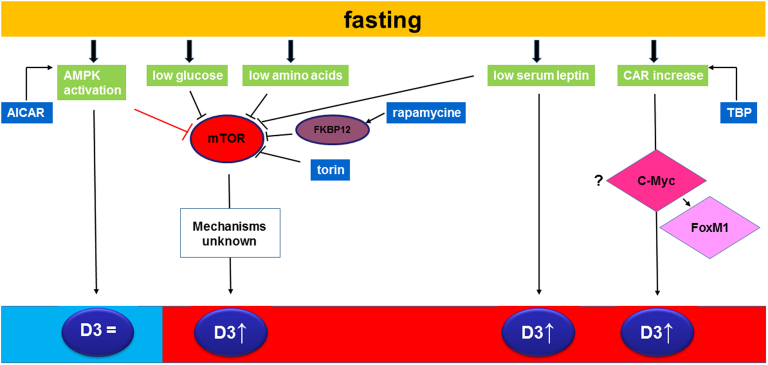Figure 7.
This schematic overview summarizes fasting induced changes in type 3 deiodinase expression and its putative mechanisms. Fasting results in activation of AMPK, decreased glucose and amino acids concentrations, decreased serum leptin and increased hepatic CAR expression. AMPK activation can be mimicked by AICAR stimulation and does not have an effect on D3 expression despite affecting mTOR. In contrast, low glucose + low amino acids (mimicked by culturing the cells in HBSS) increases D3 expression. Inhibition of mTOR signaling by rapamycin and torin also results in increased D3 expression. The downstream mechanisms are however unknown. Fasting decreases serum leptin concentrations which are known to affect D3 expression as leptin administration restores the fasting-induced increase in D3 (7). The present study shows that hepatic CAR activation by TPD increases D3 expression. Blanco-Bose et al. identified c-Myc and FoxM1 as genes induced by CAR (30). C-Myc regulates transcription of genes as an heterodimer with the transcription factor MAX via binding to the canonical Enhancer box (E-box) CACGTG but also via a variety of non-canonical binding sites like E-box sequence CATGTG and several E-box variants such as CACGCG, CACGAG, CATGCG, and CACGTT (31). We scanned the D3 promoter and found the sequences CATGTG, CACGTT and CACGAG suggesting c-Myc as a possible intermediate protein involved . c-Myc is also able to bind to the FoxM1 promoter in a CAR-dependent manner. FoxM1 or Forkhead Box M1 is a member the Forkhead superfamily of transcription factors and binds directly to genes via a consensus DNA binding site A(T/C)AAA(T/C)AA (32). Scanning the D3 promoter did not reveal any of these sequences making a role of FoxM1 in the fasting-induced D3 increase unlikely.

 This work is licensed under a
This work is licensed under a 